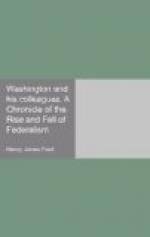for he was so much a public show that that might have
been attended by annoying practical inconvenience;
but when he rode out with Mrs. Washington his carriage
was drawn by four—sometimes six—horses,
with two outriders, in livery, with powdered hair
and cockades in their hats. When he rode on horseback,
which he often did for exercise, he was attended by
outriders and accompanied by one or more of the gentlemen
of his household. Toward the end of the year
there arrived from England the state coach which he
used in formal visits to Congress and for other ceremonious
events. It was a canary-colored chariot, decorated
with gilded nymphs and cupids, and emblazoned with
the Washington arms. His state was simplified
when he went to church, which he did regularly every
Sunday; then his coach was drawn by two horses, with
two footmen behind, and was followed by a post-chaise
carrying two gentlemen of his household. Washington
was fond of horses and was in the habit of keeping
a fine stable. The term “muslin horses”
was commonly used to denote the care taken in grooming.
The head groom would test the work of the stable-boys
by applying a clean muslin handkerchief to the coats
of the animals, and, if any stain of dirt showed,
there was trouble. The night before the white
horses which Washington used as President were to
be taken out, their coats were covered by a paste of
whiting, and the animals were swathed in wrappings.
In the morning the paste was dry and with rubbing
gave a marble gloss to the horses’ coats.
The hoofs were then blackened and polished, and even
the animals’ teeth were scoured. Such arrangements,
however, were not peculiar to Washington’s stable.
This was the usual way in which grooming for “the
quality” was done in that period.
The first house occupied by Washington was at the
corner of Pearl and Cherry streets, then a fashionable
locality. What the New York end of the Brooklyn
Bridge has left of it is now known as Franklin Square.
The house was so small that three of his secretaries
had to lodge in one room; and Custis in his Recollections
tells how one of them, who fancied he could write
poetry, would sometimes disturb the others by walking
the floor in his nightgown trying the rhythm of his
lines by rehearsing them with loud emphasis.
About a year later Washington removed to a larger house
on the west side of Broadway near Bowling Green.
Both buildings went down at an early date before the
continual march of improvement in New York. In
Washington’s time Wall Street was superseding
Pearl Street as the principal haunt of fashion.
Here lived Alexander Hamilton and other New Yorkers
prominent in their day; here were fashionable boarding-houses
at which lived the leading members of Congress.
When some fashionable reception was taking place,
the street was gay with coaches and sedan-chairs,
and the attire of the people who then gathered was
as brilliant as a flight of cockatoos. It was
a period of spectacular dress and behavior for both




